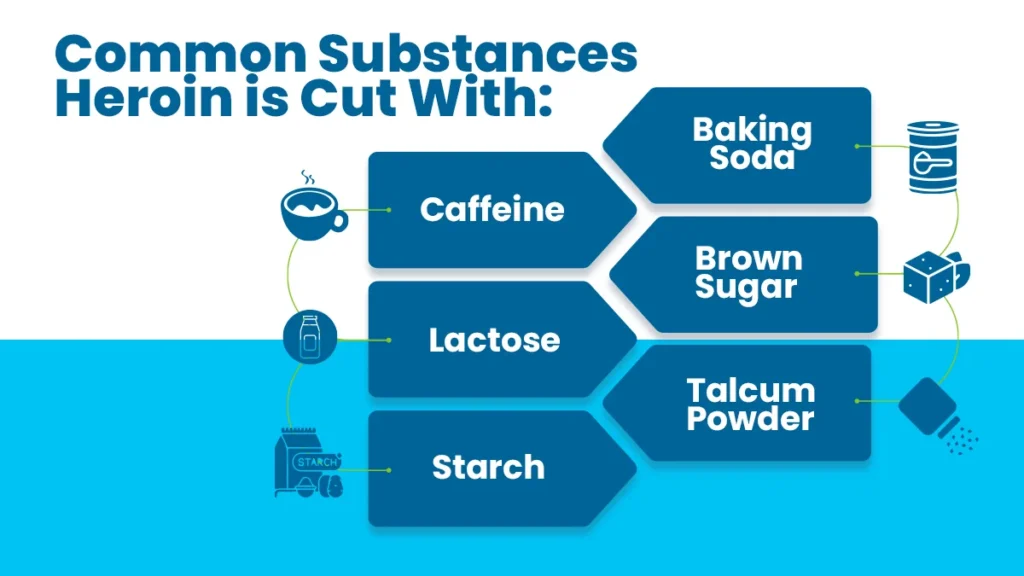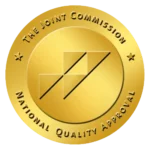Heroin, an illicit opioid drug that comes with high abuse potential, is rarely pure when sold on the streets. It’s commonly mixed or “cut” with other substances to increase its volume and potency, making it cheaper to produce and more profitable for drug dealers.
However, heroin cutting poses severe risks. The substances used as fillers can vary widely in potency and toxicity, increasing the risk of health complications. Read on as we explore the common substances used to cut heroin in the United States and the risks associated with their use.
Key Takeaways
Heroin sold on the streets is rarely pure, often containing various substances added through cutting. This article covers:
- Inert fillers and harmful chemicals are commonly used to cut heroin, altering its potency and composition.
- Various health risks are associated with cut heroin, such as increased risk of overdose and toxicity.
- Proactive approaches such as harm reduction strategies are crucial in addressing the dangers of cut heroin.
For those struggling with substance use disorder (SUD), seek professional help at The Haven Detox-Little Rock. Dial (501) 271-3342 for details!

Introduction To Heroin Cutting
Heroin, a highly addictive opioid drug derived from morphine, is infamous for its potent and euphoria-inducing effects. It is typically sold in different forms, such as white powder or brownish powder or as a black sticky substance known as black tar heroin. This powerful drug can be consumed through various routes, including injection, smoking, or snorting.
One of the concerning practices associated with heroin is known as cutting. Heroin cutting refers to the practice of mixing heroin with other substances, often to increase its volume, alter its potency, or enhance its effects. These added substances are known as “cutting agents.” Cutting heroin is a common practice among illicit drug dealers to stretch their supply and increase profits.
Cutting heroin poses serious health problems for those who use it. Individuals may unknowingly consume substances with unpredictable potency or toxic effects, increasing the risk of overdose and other adverse effects. In addition, the presence of harmful additives can lead to long-term health complications.
To avoid the risks associated with heroin cutting, individuals should take preventive measures, such as testing before use, starting with a small dose, and avoiding mixing with other drugs. However, the safest choice regarding heroin is to avoid it altogether and seek help if struggling with addiction.
Common Substances Heroin is Cut With
When heroin hits the streets, it’s rarely in its pure form. Instead, dealers often mix or “cut” it with various substances. Some common substances heroin is cut with include:
Caffeine: A stimulant found in coffee and tea, caffeine might be added to heroin to give users a temporary energy boost.
Lactose: A sugar commonly found in milk, lactose is sometimes used to dilute heroin and increase its volume.
Brown Sugar Or Powdered Milk: Similar to lactose, brown sugar or powdered milk is added to bulk up heroin and make it easier to handle.
Talcum Powder: This fine powder is often used in baby products and cosmetics. It’s added to heroin to dilute it and give it a powdery texture.
Baking Soda: A household ingredient, baking soda is sometimes mixed with heroin to alter its effects or increase its volume.
Starch: Starch, a carbohydrate found in foods like potatoes and rice, is used as a cutting agent to stretch the amount of heroin available for sale.
Fentanyl: A powerful synthetic opioid, fentanyl is sometimes added to heroin to increase its potency. However, this can greatly increase the risk of overdose.
Methamphetamine: Meth, a stimulant drug, may be mixed with heroin to create a more intense and potentially dangerous high.
Paracetamol (Acetaminophen): This pain relief medication is sometimes included to mimic the similar effects of pure heroin or to add bulk.
Quinine: An anti-malarial drug, quinine is sometimes added to heroin to give it a bitter taste, which users may associate with higher quality.
Procaine: A local anesthetic, procaine, may be added to heroin to mimic the numbing effects of the heroin.
Laundry Detergent: This household product may be added to street heroin to increase its bulk and alter its appearance.
Rat Poison: Shockingly, some unscrupulous dealers may add rat poison to heroin to increase its weight and potency, posing a severe risk to users’ health.
These substances not only dilute the heroin but also pose serious health risks. Therefore, it’s vital for individuals using heroin or know someone who does to be aware of the risks associated with these adulterants and seek help if needed.
Health Risks Associated With Cut Heroin
Cut heroin, like any illicit drug, poses significant health risks to users. Here are some of the potential dangers associated with cut heroin:
Overdose: Heroin cut with potent substances like fentanyl significantly increases the risk of overdose. Even small amounts of these additives can lead to respiratory depression and death.
Toxicity: Heroin cut with harmful chemicals or contaminants can result in toxicity, leading to organ damage, neurological issues, and other severe health complications.
Infections: Injecting cut heroin increases the risk of infections, including HIV/AIDS, hepatitis B and C, and other blood-borne illnesses, due to shared needles and unsanitary injection practices.
Addiction: Regular use of cut heroin can quickly lead to addiction, a chronic disease characterized by compulsive drug-seeking and use despite harmful consequences. The person experiences withdrawal symptoms upon suddenly stopping or limiting their heroin use.
Physical Health Problems: Long-term use of cut heroin can cause a range of physical health problems, including cardiovascular issues, respiratory problems, and gastrointestinal issues.
Mental Illnesses Heroin use, particularly when cut with potent substances, can exacerbate mental health issues such as depression, anxiety, psychosis, and cognitive impairments.
Remember, the risks associated with cut heroin can vary depending on the specific additives used and the individual’s overall health and circumstances. Seeking professional help is essential to mitigate these risks.
Addressing The Issue Of Cut Heroin
Addressing the issue of heroin cutting is crucial for the well-being of people struggling with addiction.
Educate Yourself
Start by educating yourself about the dangers of cut heroin and how to recognize the signs of adulteration. Understanding the risks involved can help you make informed decisions about drug use and seek help when needed.
Seek Professional Help
If you or someone you know is struggling with heroin addiction, don’t hesitate to seek help from medical professionals. Treatment options such as counseling, medication-assisted treatment (MAT), and support groups can provide the necessary support and guidance for recovery.
Consider Harm Reduction Strategies
Explore harm reduction strategies such as needle exchange programs, safe injection sites, and heroin overdose prevention education. These initiatives aim to reduce the negative consequences of drug use and promote safer practices.
Build Support Networks
Surround yourself with supportive friends, family members, or peers who understand your struggles and are willing to offer encouragement and assistance. Building a strong support network can provide emotional stability and motivation for recovery.
Develop Coping Skills
Learn healthy coping skills and alternative ways to manage stress, anxiety, and other triggers that may lead to substance abuse. Engage in activities that promote physical and emotional well-being, such as exercise, mindfulness, and hobbies.
Avoid Risky Situations
Identify and avoid situations or environments where heroin use is prevalent or where you may be tempted to use it. By steering clear of risky situations, you can reduce the likelihood of relapse and protect your health and well-being.
By taking these steps, individuals can empower themselves to make healthier choices and work towards recovery and well-being.
Frequently Asked Questions (FAQs)
Why do dealers choose to cut heroin with other substances?
Dealers choose to cut heroin with other substances to increase their profits. By adding fillers or illegal drugs, they can stretch their supply and sell more products. Additionally, cutting heroin can help dealers adjust the potency of the drug, making it more appealing to different customers. However, this practice puts users at risk, as they may unknowingly consume harmful additives or dangerous drugs like fentanyl.
Can the substances used to cut heroin affect its potency or the user’s health?
The substances used to cut heroin can affect both its potency and the individual’s health. Inert fillers can dilute the heroin, reducing its strength and altering its effects. Harmful additives like fentanyl or toxic chemicals can increase potency, leading to overdose or severe health complications. Additionally, contaminants may introduce infections or other health risks. Individuals need to be aware of these dangers and seek support if they are struggling with drug abuse and addiction.
What does it mean when a drug is “cut” with another drug?
When a drug is “cut” with another drug, it means that additional substances are mixed into it before it is sold. This practice is common with drugs like heroin, where dealers add fillers or cheaper substances to stretch their supply and maximize profits. Sometimes, drugs are also cut with other drugs to change their effects or make them more appealing to customers. However, cutting drugs can be dangerous, increasing the risk of overdose or other health problems.
Healing Begins At The Haven Detox-Little Rock
Feeling trapped by heroin use disorder? There’s hope for you! At The Haven Detox-Little Rock, we’re here to guide you toward a brighter tomorrow.
Our comprehensive treatment program begins with a medical detox program, ensuring your safety as your body rids itself of harmful toxins. From there, our residential rehab offers round-the-clock care, providing you with the support and resources you need to heal.
During your time with us, you’ll benefit from a combination of proven therapies, appropriate medications, NAD IV therapy, and holistic approaches tailored to meet your unique needs.
Take that first step today by calling (501) 271-3342. Our compassionate team is ready to walk beside you on your journey to recovery.





